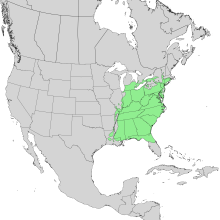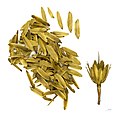Tulip tree
| Tulip tree | ||||||||||||
|---|---|---|---|---|---|---|---|---|---|---|---|---|

Tulip tree ( Liriodendron tulipifera ), flowering |
||||||||||||
| Systematics | ||||||||||||
|
||||||||||||
| Scientific name | ||||||||||||
| Liriodendron tulipifera | ||||||||||||
| L. |
The tulip tree ( Liriodendron tulipifera ) is one of two species of the genus tulip trees ( Liriodendron ) in the family of Magnoliaceae (Magnoliaceae). It is common in North America.
description

On the left, for a size comparison, a sessile oak that is also over 200 years old
Vegetative characteristics
The tulip tree is a deciduous, deciduous tree . It usually has a stately habit and reaches heights of over 40 m in forest or plantation networks. Maximum values are 60 m high and a trunk diameter of 150 cm. In young specimens, the treetop is narrow and conical, in older ones it is arched and towering, but never very wide and it is rather powerfully columnar. In the leafless state it is very light and the branches are wide. When leafy, the tree forms a dense, closed crown. The age of the oldest specimen in the original distribution area is given as a maximum of 450 years. It is located in Queens, New York City and is called the "Queens Giant", reaches a height of almost 41 m and a diameter of almost 2 m.
The trunk of old trees stands on a hemispherical foundation that is formed from the root system. The advantages are greater stability and protection against flooding.
The gray, brown or brown-orange colored bark is covered with fine, flat ridges like a net. The young twigs are hairless, slightly frosted, the leaf scars are clearly visible. The buds are about 1 inch long, oval, slightly curved and slightly compressed.
The leaves are divided into a petiole and a leaf blade. The petiole is 10 to 12 inches long. The leaf shape is peculiar and unmistakable: it is axially symmetrical to the stem. Young leaves are still folded together on this axis. The leaf blade is square with a length of 10 to 15 centimeters and a width of 12 to 20 centimeters and is divided into four unequal lobes. The long sides of the lobes are almost parallel. At the top, the sheet has just been cut off or has a margin. The top of the leaf is shiny and bright green. The underside of the leaf is lighter and waxy. The leaves are hairless and turn golden yellow in autumn.
Generative characteristics
The flowering period extends from April to May. The flowers are solitary at the ends of branches. The hermaphroditic flowers are initially cup-shaped when they open, later they open wider and become bell-shaped. The inflorescence is simple and petal-like. The bracts are bluish-green at the base, yellow-orange above, then green again. The stamens are thick, fleshy, and 3 to 5 inches long. The carpels are attached to a cone in the center of the flower.
The fruit stand resembles a conifer cone. The fruits are winged and contain one or two seeds.
Chromosome set and ingredients
The number of chromosomes is 2n = 38.
All parts of the plant, especially wood and bark, are poisonous to humans. The alkaloid glaucin is contained in the wood, digitaloid compounds in the bark , and saponin-like and cyanogenic substances in the leaves .
evolution
Many botanists consider the magnolia-like plants, which have been detectable for at least 100 million years (English term by the Angiosperm Phylogeny Group : magnoliids ), to be the most original of all living flowering plant species. This includes the tulip tree.
distribution
The tulip tree is native to eastern and southeastern North America. The natural area has its northern limit in Rhode Island , Massachusetts and Vermont to the west in the extreme south of Ontario , further to the south of Michigan , the south coast of Lake Huron , north coast of Lake Erie , Niagara Peninsula . From here the area boundary goes south across southern Illinois , southeast Missouri , eastern Arkansas and northern Louisiana . The southern border goes through northern Florida .
The majority of the population is in the Appalachian Mountains and on the Piedmont plains from Pennsylvania to Georgia. In the north of the area, the altitude limit is around 300 meters, in the south at 1380 meters.
In Germany it is meanwhile being planted on a trial basis in order to broaden the range of tree species due to global warming. Larger stocks can be found between Rastatt and Karlsruhe.
use
In Northeast America, the tulip tree is one of the most important deciduous tree species. The trunk wood (American Whitewood, Tulipanero) is mainly used for doors, windows, veneers, plywood, cladding, shelves and molds. It is also used to make toys, baskets, musical instruments and coffins. Pencils and matches are made from weaker wood. The wood is stable, crack-proof, nail-proof and easy to work with. The heartwood is durable, the sapwood is not. In the Southern Appalachian Mountains, the tulip tree is of economic importance as a raw material for pulp and paper production. The pulp is stronger than poplar pulp. The tulip tree plays a certain role as a bee pasture . Young trees provide up to 3.6 kg of nectar per season , which corresponds to around 1.8 kg of honey.
Due to the large, attractive flowers and the autumn color, the tulip tree is also planted outside its natural area as a park and ornamental tree, in Europe since 1663, where it is considered absolutely frost-hardy. An approx. 300 year old copy is in the Trebnitz Castle Park . The tulip tree is the official state tree of the US states of Kentucky , Indiana and Tennessee .
photos
About 400 years old tulip tree in Harpstedt
literature
- Bruno P. Kremer: Trees. Native and introduced species in Europe. Steinbach's natural guide, Mosaik Verlag, Munich 1984, p. 160. ISBN 3-570-01188-7 .
- Peter Schütt, Ulla M. Lang: Liriodendron tulipifera . In: Schütt, Weisgerber, Schuck, Lang, Stimm, Roloff: Encyclopedia of the deciduous trees. Nikol, Hamburg 2006, pp. 311-320. ISBN 978-3-937872-39-1 .
Web links
- Thomas Meyer: Data sheet with identification key and photos at Flora-de: Flora von Deutschland (old name of the website: Flowers in Swabia )
- Tulip tree on gift Pflanzen.com .
- Liriodendron tulipifera inthe IUCN 2013 Red List of Threatened Species . Listed by: NT Ban, 1998. Retrieved November 13, 2013.
- Leaflet Whitewood ( Memento from November 15, 2016 in the Internet Archive ) (PDF; 1.4 MB).
Individual evidence
- ↑ Liriodendron tulipifera at Tropicos.org. In: IPCN Chromosome Reports . Missouri Botanical Garden, St. Louis
- ↑ The Tulip Tree: A Molecular Fossil on plant research.de, accessed on November 15, 2016.
- ↑ Brief portrait of the tulip tree (Liriodendron tulipifera) on waldwissen.net, accessed on April 10, 2019.
- ↑ Destination Brandenburg: Your portal for holidays and excursions, information board in the park. March 3, 2016, accessed June 25, 2020 .















